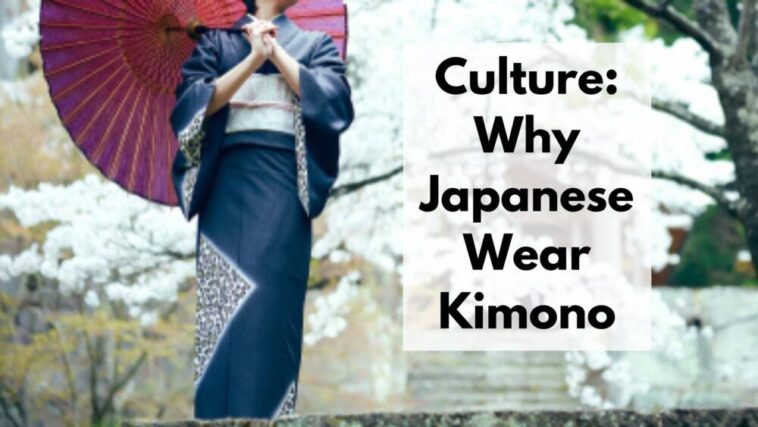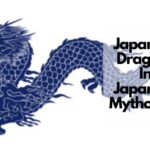Kimonos and yukatas are traditional Japanese clothing but what is its significance? Read on to find out why Japanese wear kimono?
Dazzling with vibrant colors and intricate designs, kimonos are a coveted treasure. But where to find the perfect one in Japan? Look no further! This guide explores top shopping destinations, from bustling department stores to charming specialty shops, to help you find your dream kimono.
Page Contents
Why Japanese Wear Kimono?
The kimono is a traditional Japanese garment worn for formal occasions, cultural ceremonies, and special events. It symbolizes cultural identity, historical continuity, and artistic expression. Kimonos are chosen based on seasonal changes and serve as artistic canvases with intricate designs.
They strengthen family bonds through heirlooms, represent elegance, and offer tourists a way to engage with Japanese culture.

While less common in daily wear due to modernization, the kimono remains a revered symbol of Japan’s rich heritage and values.
Related: Where to buy kimono in Japan
History of Kimono and Yukata
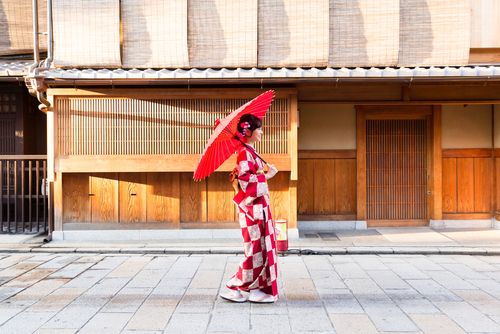
To dive deep into knowing about the history of Kimono, you must first know the meaning of the word itself. Kimono refers to clothing in Japanese but now it is known for a traditional way of clothing.
Before Kimono actually came into existence, people of Japan used to wear ensemble clothing that used to be full of accessories and with different lower and upper garments. After some time, that is the Helen period, an approach was made towards making Kimono-type clothing.
The technique they introduced was not at all difficult as it didn’t require any body measurement or size. All they used to do is cut straight cloth pieces and later stitch them together to make a kimono.
Kimono being traditional clothing has different reasons behind it. Firstly, it is a very simple and subtle way of dressing up and has add-on advantages to it such as it is suitable to wear in all types of seasons.
You could put on layers to keep yourself warm in winters and get yourself a light fabric kimono made for summers. They are easily foldable and felt extremely comfortable for all.
With time, people also experimented with colorful kimonos and made different combinations that looked pretty amazing at that time. After every combination, either a political thought or a seasonal beauty was represented.
At one point in time, only bright colors were preferred by both men and women. Color played a very important role as it used to signify or represent a group or a leader.
Just like rulers in Mughals and other dynasties used to wear extremely different outfits with excessive jewelry and crowns, in the same way, Japanese kimono clothing played the same role.
Just like any part of the world or a human being enters the new generation, the kimono also has a journey of its own where it changes from time to time. When the Tokugawa warrior clan ruled over Japan, the whole scenario changed. Now there were uniforms worn by each samurais leader.
Clothing became an identity of a person and kimono, at that time, grew like no other clothing style. Till today as well, it is considered the most essential part of Japanese culture and is respected in the country.
When the Western people invaded Japan, western clothing was made mandatory to be worn but the common people wore kimono and were identified on the basis of that.
A particular kimono would tell you about your background, your identity, and social status. This was done on the basis of fabric, pattern, and color of choice.
Nowadays, wearing kimono has become rare and people just wear them on special Japanese occasions or on a particular day such as wedding parties, tea parties, mourning, and others.
Kimono of the Nara Period
The Nara period (710-794 AD) in Japan was pivotal for the inception of the kimono, a garment that has come to symbolize Japanese culture.
During this era, the kimono’s design was influenced by Chinese court fashion, leading to the creation of the “kosode,” a prototype of the modern kimono.
Silhouette and Influence: Chinese robes like the “chao-fu” shaped the kimono’s silhouette, transitioning from draped styles to the more tailored kosode. This innovation introduced smaller, overlapping sleeves, a departure from the previous norms.
Fabric and Motifs: Natural materials like silk and hemp were used for kimono fabrics. Designs embraced simplicity with nature-inspired motifs such as flowers and birds. Artistic weaving and dyeing techniques laid the groundwork for future intricate designs.
Social Significance: Kimono became markers of social status and rank, with colors and styles distinguishing various classes. They also played a vital role in court ceremonies, adding a layer of meaning to the attire’s elegance.
Legacy and Influence: The kosode’s design principles and appreciation for nature’s influence remained pivotal for the kimono’s evolution. The Nara period’s aesthetics shaped the enduring essence of the kimono as it evolved to represent Japanese tradition and cultural identity.
Kimono of the Heian Period
The Heian period (794-1185 AD) witnessed the kimono’s transformation into a canvas of artistic expression. Women adorned themselves in the elaborate “junihitoe,” layering fabrics to reflect status and season.
Colors symbolized youth or maturity, while floral motifs showcased nature’s beauty. Techniques like “yuzen” dyeing and gold embroidery added opulence.
Kimono not only indicated social hierarchy but also starred in literary works like “The Tale of Genji” and art, embodying the era’s elegance and culture.
Kimono of the Kamakura Period
The Kamakura period (1185-1333 AD) in Japan was marked by a dynamic blend of societal change, military upheaval, and cultural evolution.
This period also witnessed a notable transformation in kimono design, where practicality and elegance converged to shape a distinct style.
Simpler Silhouettes: The kimono of the Kamakura period departed from the elaborate layering of the previous eras. The kosode, characterized by smaller sleeves and a tailored fit, became a prominent choice. This shift aligned with the changing social dynamics, catering to the needs of the rising warrior class.
Emphasis on Utility: With the emergence of samurai culture and feudal warfare, kimono design adapted to the demands of the time. Earthy and subdued colors gained favor, reflecting a utilitarian aesthetic that catered to the practical needs of warriors on the battlefield.
Zen Influence: Zen Buddhism’s philosophy of simplicity and mindfulness made its mark on Kamakura period kimono. This influence was manifested in the choice of muted color palettes and unobtrusive designs. Kimono, through their understated elegance, became a reflection of inner tranquility and harmony.
Patterns and Textures: While simplicity was key, the Kamakura period also witnessed an appreciation for intricate patterns and textures. Nature-inspired designs such as bamboo and pine were woven or dyed onto the fabric. The introduction of textured fabrics like “nuihaku,” adorned with gold or silver leaf, added depth and richness.
Societal Dynamics: The rise of the samurai class brought about significant shifts in societal norms. Kimono designs echoed these changes, as the attire needed to facilitate free movement and efficiency in battle. The kimono thus became a canvas that mirrored the evolving cultural and social landscape.
Cultural Significance: The kimono of the Kamakura period represented more than just clothing; it embodied a fusion of practicality and elegance that echoed the spirit of the times. As Japan underwent transformation, the kimono served as a visual testament to the changing priorities and values of the society it adorned.
In summary, the kimono of the Kamakura period encapsulated a period of transition, blending the necessities of a warrior culture with the timeless elegance of traditional attire.
This fusion created a unique aesthetic that not only reflected the era’s practical demands but also showcased the enduring cultural identity of Japan.
Kimono of the Edo Period
The Edo period (1603-1868 AD) in Japan marked a period of stability, peace, and cultural flourishing under the Tokugawa shogunate.
During this time, the kimono evolved into an emblem of elegance and societal norms, reflecting both the rigid social structure and the artistic richness of the era.
Refinement in Simplicity: The Edo period witnessed a departure from the extravagant styles of previous eras. The kosode, which had gained popularity in earlier periods, evolved into a refined, more accessible garment. The focus shifted from intricate layering to simpler, single-layer kimono adorned with subtle yet exquisite designs.
Sumptuary Laws and Social Signifiers: The Tokugawa shogunate enacted sumptuary laws that restricted extravagant displays of wealth through clothing. Kimono design began to convey social status more discreetly, with materials, colors, and patterns indicating the wearer’s rank and class within the rigid hierarchy.
Artistic Flourishing: Despite the societal restrictions, the Edo period witnessed a surge in artistic expression. Kimono designs were infused with intricate hand-painted motifs, and dyeing techniques like “yuzen” became increasingly sophisticated. Nature, landscapes, and scenes from daily life found their way onto the fabric, turning kimono into wearable canvases.
Rise of the Merchant Class: The Edo period saw the emergence of a prosperous merchant class, which had substantial influence on kimono fashion. Their preference for luxurious yet understated designs led to the creation of textiles with intricate patterns and elegant motifs, striking a balance between opulence and modesty.
Regional Styles and Uniqueness: Different regions developed their own distinct kimono styles during the Edo period. These regional variations allowed for self-expression while adhering to broader social norms. The kimono thus became a reflection of both personal taste and cultural identity.
Changing Roles and Styles: As the Edo period progressed, women’s roles and fashion underwent transformation. The “tomesode” kimono, featuring auspicious motifs on the lower portion, became popular as formal wear for married women, while younger generations favored vibrant and playful designs.
Legacy and Transition: The Edo period’s influence on kimono design is profound, with many aspects still resonating in modern times. This era laid the groundwork for the kimono’s transition from a formal attire to a daily wear item.
In essence, the kimono of the Edo period encapsulated the balance between tradition and innovation. While adhering to societal norms, these garments became vehicles for artistic expression and personal identity. The kimono’s legacy from this era continues to be admired and celebrated for its elegance, subtlety, and unique role in shaping Japan’s cultural tapestry.
Kimono in the Modern World
Although some people still are true to their tradition and wear kimonos on different occasions to respect the culture, most of it is about fashion today. It is not just Japan that has influenced the world with its traditional clothing but there are different cultures too.
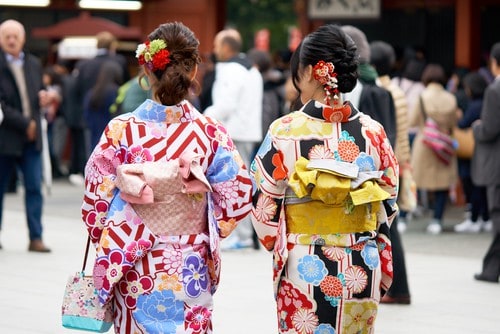
In today’s world, people are more influenced by western culture and even follow it in their daily life, and wearing a kimono is just about looking fashionable.
Youngsters wear these beautiful patterns and colors to make a fashion statement and also to look unique on social media. Everybody has their opinion which also differs while you dress up in a significant dress.
It is the same with a kimono, some wear it to cherish the historical meaning to it and some are just fascinated with its gorgeous outlook. Although, designers these days tend to take a step towards bringing these Japanese traditional wear to daily wear.
Also, a certain amount of people are eager to try this breathtakingly gorgeous garment for formal occasions like weddings and parties.
Also, people now take the kimono style and modernize it in their own way to get a perfect outfit. Style of sleeves and its length are taken to a whole different level and are enjoyed wearing. Nowadays, it is more of a blend of contemporary and modern kimono dress that excites people across the world.
The Importance of Motifs on Kimonos
Kimonos, the traditional Japanese garments renowned for their elegance and cultural significance, are much more than just pieces of clothing.
They are intricate canvases that showcase a wide array of motifs, each laden with symbolism, reflecting personal identity, and embodying artistic expression.
The motifs on kimonos play a pivotal role in conveying messages, stories, and emotions that contribute to the overall beauty and meaning of these garments.
- Symbolic Language: Motifs on kimonos often convey intricate messages deeply rooted in Japanese culture and history. Nature-inspired symbols like cherry blossoms symbolize the ephemeral nature of life, while cranes represent longevity and good fortune. These motifs transform the kimono into a visual language that communicates sentiments and beliefs without the need for words.
- Seasonal Connections: Japanese culture holds a profound reverence for the changing seasons, and kimono motifs reflect this connection. Flowers, plants, and animals are chosen based on their relevance to different times of the year. A kimono adorned with maple leaves might evoke thoughts of autumn, while plum blossoms represent the arrival of spring.
- Cultural Identity: Motifs on kimonos often reflect regional or familial affiliations. Certain patterns and symbols are associated with specific localities or family crests, allowing wearers to proudly showcase their heritage. These motifs strengthen the link between personal identity and clothing, fostering a sense of belonging and tradition.
- Occasions and Rituals: Kimonos are worn during a variety of occasions and ceremonies, each with its own set of appropriate motifs. Weddings, coming-of-age celebrations, and festivals all have their designated symbols, contributing to the visual storytelling of the event. These motifs help create a sense of occasion and connect the wearer to their cultural heritage.
- Artistic Expression: Motifs on kimonos serve as a canvas for artistic expression and craftsmanship. Intricate dyeing techniques like “yuzen” and “shibori” allow for intricate and detailed designs. The combination of motifs, colors, and patterns is a manifestation of the artist’s skill and creativity, transforming the kimono into a wearable work of art.
- Continuity and Modernity: While traditional motifs remain prevalent, modern kimono designers also incorporate contemporary elements and reinterpretations. This fusion of tradition and innovation ensures that the motifs on kimonos continue to evolve while maintaining their cultural significance.
In conclusion, motifs on kimonos are not mere embellishments; they carry stories, cultural values, and personal narratives.
They transform these garments into conduits of tradition, visual expressions of emotion, and reflections of the natural world.
The motifs on kimonos serve as a testament to the intricate tapestry of Japanese culture and provide a timeless glimpse into the beauty of human creativity and the art of conveying meaning through clothing.
What is a Kimono?
Kimono is a traditional clothing style followed in Japanese culture by both men and women. It is a T-shaped cloth that is wrapped around the body and tied on the left. There are different types of kimonos available in different fabrics and be chosen as per the occasion you want to wear.
They are extremely comfortable to wear and quite airy and breathable. Women wear them with ‘obi’, which is a belt that is worn around their waist to keep the cloth intact. From base colors to floral prints, you can find various different patterns and designs that look absolutely beautiful.
Types of Kimonos and Why People Wear Them
There are multiple types of kimonos available with a special meaning attached to them as per their patterns, prints, and colors. You can see kimono of every variety such as formal, casual, daily wear, as well wedding wear.
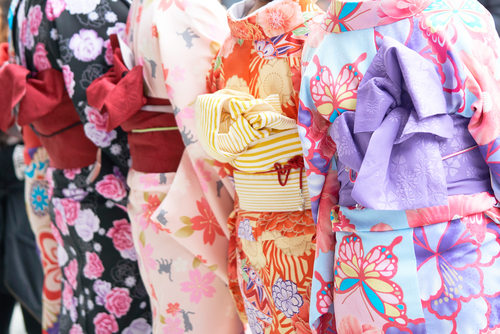
Furisode kimono, which comes under the formal category and has three distinctive types to it. This type of kimono is worn by married and unmarried women but of a different type of sleeve and pattern. Three types have short, medium, and long sleeves and are called Kofurisode, chu-furisode, and Ofurisode, respectively.
To adhere to the formal dress code of a particular gathering, women are supposed to wear an Ofurisode kimono which has paddings attached to it with long sleeves that look elegant and formal. Under the same variety comes this type with no padding attached and made with a soft fabric, Chu-furisode kimono.
This was mostly preferred by unmarried girls as it has beautiful and bright prints. Kofurisode, the last one from this variety, is the one with shortest sleeves and is worn in casual form.
Kimonos also differed on the basis of social status. Wealthy people would wear silk kimonos on a daily basis rather than saving them for special occasions.
Although there are thousands of patterns that a kimono could have, each one of them has a specific significance that reflects beautifully. For example, a kimono printed with an animal print, such as a crane, signifies long-term good fortune and happiness and also the lifespan of a thousand years.
In terms of animal print only, mandarin duck-printed kimonos also have a positive meaning of love, loyalty, and happiness and such types of kimonos are worn by people on happy occasions like marriages, baby showers, life achievements, etc.
The one with a wave crest represents that you long for a peaceful life and the one with hemp leaves symbolizes growth. Such beautiful meanings after a piece of clothing make it more valuable and attractive
Why do people wear kimonos?
There is a very meaningful answer to it after you come across their advantages, their types, their hidden significance, and many more. After prints, even colors have a hidden meaning, which is very common in every culture.
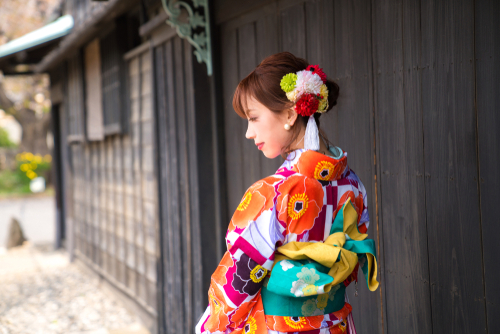
For a wedding occasion, a bride is supposed to wear white kimono dress as it shows her acceptance of the family while also accepting the ways of her husband’s life from the heart.
White color gets mixed up with any color beautifully and this is why brides wear this as their bridal outfit.
At sad moments, like death or mourning, the Japanese prefer wearing black as it represents sadness. Colorful kimonos have their meanings directly connected to nature such as blue, as it comes from indigo, which symbolizes a healing color from bites, infections, and allergies.
People also wear kimonos of different colors to express their love towards the type of clothing and the season. For summers, the preferred colors are dark blue and lavender, for the spring season, pale colors are worn such as lime green and light yellow.
For autumn, sober and natural colors are worn and for winters, it is all about bright shades like red and black.
Kimono clothing is just not a piece of cloth that is just known for its beautiful colors and prints. This garment is respected and is kept as a precious thing in families.
Earlier, these kimonos were made with extremely good quality fabrics that you might not find today and so they are preserved by the families and passed through generations.
Different cultures have different things to pass on as pride of their origin and so Japanese have kimonos for that.
You must also know how expensive these kimonos are when it comes to a particular kind of fabric. For the ones for special occasions, they are completely handmade and are made while using expensive materials to beautify them and give them a unique look.
Wearing a kimono also shows that you respect the culture and manners and that you follow it with heart. If you ever plan to visit Japan, then do get yourself a kimono to enjoy the beauty of this lovely culture.
The Meaning of Different Kimono Colors
Colors play an essential role in the symbolism and meaning behind the various types of kimonos.
Each color holds significance and represents different concepts, emotions, and occasions. Here are some common kimono colors and their associated meanings:
- Red (Akai): Red is a vibrant and auspicious color in Japanese culture. It symbolizes life, passion, energy, and vitality. Red kimonos are often worn during joyous celebrations, such as weddings or festivals, as they bring good luck and prosperity.
- White (Shiroi): White is associated with purity, innocence, and new beginnings. It is often worn by brides during traditional Japanese weddings to symbolize their pure intentions and the start of a new chapter in their lives.
- Black (Kuroi): Black is a color that represents formality, elegance, and sophistication. It is commonly worn during formal events or ceremonies. Black kimonos can also denote a sense of mystery and intrigue.
- Blue (Aoi): Blue is a calming color that signifies tranquility, serenity, and stability. It is often seen in kimonos worn during contemplative or meditative practices. Blue is also associated with the sea and is frequently used to represent water elements in kimono designs.
- Yellow (Kiiroi): Yellow is the color of brightness, optimism, and prosperity. It symbolizes the sun and its life-giving energy. Yellow kimonos are commonly worn during festive occasions, as they bring joy and happiness.
- Green (Midorii): Green represents nature, fertility, and vitality. It is associated with new growth and the abundance of life. Green kimonos are often worn during springtime events, such as cherry blossom viewing, to celebrate the renewal of nature.
- Purple (Murasaki): Purple is a color that symbolizes nobility, luxury, and spirituality. It has historically been associated with the imperial court and aristocracy. Purple kimonos are worn on special occasions and formal ceremonies to convey a sense of prestige.
- Pink (Momoiro): Pink is a color associated with femininity, tenderness, and youthfulness. It represents love, romance, and affection. Pink kimonos are popular choices for young women and can be seen during cherry blossom festivals, as the soft pink hues complement the delicate beauty of the blossoms.
- Gold (Kin): Gold is a color of wealth, opulence, and prosperity. It is often used in kimono designs to add a touch of luxury and elegance. Gold accents are frequently seen on formal kimonos, obis (sashes), and other accessories.
How to wear a Japanese kimono?
Wearing a Japanese kimono is a traditional and ceremonial process. It involves several steps to ensure that the kimono is worn correctly and with proper respect for the culture. Here’s a general guide on how to wear a Japanese kimono:
- Undergarments: Start by putting on a layer of undergarments, which typically include a slip-like garment called “hadajuban” and a half-collar known as “nagajuban.”
- Wrap the left side over the right: When wearing a kimono, it’s important to remember that the left side should always be wrapped over the right side. This order is reserved for the deceased, so reversing it is considered disrespectful.
- Obi (belt): Tie the obi around your waist, making sure it is centered at the back. The obi can be wide and decorative or narrow, depending on the formality of the occasion. Secure it with a knot, such as the “taiko” or “Otaiko” knot, and arrange the bow at the back.
- Adjust the kimono length: The length of the kimono should be adjusted to your height. Lift the hem of the kimono to your ankles, ensuring that the front and back are at equal lengths.
- Collar and sleeves: Adjust the collar to sit straight and fold the excess fabric under the collar to create a clean appearance. The length of the sleeves can also be adjusted by folding them back slightly or leaving them loose, depending on the formality of the kimono.
- Obijime and obidome (optional): If you wish, you can add an obijime (a decorative cord) around the obi, and an obidome (an ornament) can be attached to the obijime for added elegance.
- Footwear: Complete the kimono ensemble by wearing traditional Japanese socks called “tabi” and slip-on sandals known as “zori” or “geta,” depending on the occasion.
Can I wear a kimono if I’m not Japanese?
Yes, it is acceptable for anyone, regardless of their cultural background, to wear a kimono. However, it’s important to approach it with respect, understanding its cultural significance. Learning about proper styling and occasions for wearing a kimono is recommended.
There are resources available, such as kimono rental services and cultural events, to help you wear a kimono correctly and appreciate its cultural heritage. Remember to appreciate and respect the traditions and history associated with the garment.
Can anyone wear a kimono?
Yes, anyone can wear a kimono. While the kimono has deep cultural roots in Japan, it is not exclusive to Japanese individuals. People from various cultures and backgrounds can appreciate and wear a kimono, especially as a fashion choice or as a means of cultural exploration.
However, it’s important to approach it with respect and understanding, acknowledging its cultural significance. Learning about the proper way to wear a kimono and its historical context is advisable to ensure that you appreciate and respect the garment’s cultural heritage.
Do men wear kimonos in Japan?
Yes, men do wear kimonos in Japan for formal or ceremonial occasions. They have their own style of kimono called “kimono” or “montsuki hakama.” It features simpler patterns, darker colors, and is often worn with hakama, wide-legged pants. Men’s kimonos are typically seen at weddings, tea ceremonies, festivals, and other formal events.
Why did the Japanese stop wearing kimono?
The decline in the regular wearing of kimonos in Japan can be attributed to a combination of social, cultural, and economic factors that have emerged over the past century.
The introduction of Western clothing during the Meiji era in the late 19th century marked a significant shift in Japanese fashion.
As Japan embraced modernization and Westernization, Western-style clothing became associated with progress, modernity, and global engagement. This shift was further reinforced by the practicality and convenience of Western attire for the rapidly changing urban lifestyle.
Additionally, the complex and time-consuming process of wearing a kimono, including the intricate layering and obi tying, made it less suitable for the fast-paced demands of modern life.
Consequently, the kimono became reserved primarily for ceremonial occasions, festivals, and cultural events.
The trend towards Western clothing also had economic implications, as the production of kimonos required specialized skills and materials, making them more expensive compared to mass-produced Western clothing.
As a result, the tradition of daily kimono wear gradually faded, with modern generations opting for Western clothing for its convenience, affordability, and alignment with contemporary values.
Despite this shift, the kimono remains an enduring symbol of Japan’s cultural heritage and is still revered for its artistry and significance in special settings.
Why is kimono right over left?
Kimonos are traditionally worn left over right, unless the wearer is deceased. This is because the left side of the body is considered to be the “clean” side, while the right side is considered to be the “dirty” side. The left side is also considered to be the more important side, as it is the side that is closest to the heart.
There are a few different theories about why this custom originated. One theory is that it is based on the Chinese philosophy of yin and yang. Yin is associated with the left side of the body, and yang is associated with the right side of the body.
Yin is considered to be the feminine and passive principle, while yang is considered to be the masculine and active principle. Wearing the kimono left over right is a way of balancing these two principles.
Another theory is that the custom of wearing the kimono left over right originated in the Buddhist tradition.
In Buddhism, the left side of the body is associated with the bodhisattva Kannon, who is a symbol of compassion and mercy. Wearing the kimono left over right is a way of showing respect for this deity.
Whatever the origin of the custom, it is still observed today in Japan. If you see someone wearing a kimono, you can be sure that it is worn left over right.
What is worn under a kimono?
Traditionally, several layers of clothing are worn under a kimono to create its desired shape and to provide comfort and warmth. The layers may vary depending on the type of kimono and the season, but the basic components typically include:
- Undergarments (Hadajuban): This is a lightweight, knee-length undergarment that is worn directly against the skin. It helps to protect the kimono from sweat and oils while providing a smooth base for the layers above.
- Nagajuban (Kimono Slip): This is a longer, more formal undergarment that goes over the hadajuban. It usually has a collar that peeks out from the kimono’s neckline. The nagajuban helps to give the kimono its proper shape and adds an additional layer of insulation.
- Datejime or Koshihimo: These are narrow belts or cords that are tied around the waist over the nagajuban. They help secure the layers and create a smooth base for the obi (sash) that will be tied around the waist.
- Tabi Socks: Tabi socks are split-toed socks that are designed to be worn with traditional Japanese footwear like geta or zori. They are an essential part of the kimono ensemble.
- Under Kimono (Nagagi): This is a lightweight, unlined kimono that goes over the nagajuban. It adds an extra layer and helps to protect the main kimono from sweat and oil.
These undergarments and layers serve both functional and aesthetic purposes, contributing to the overall appearance and comfort of the kimono. They also help to preserve the kimono itself by acting as a barrier against the body’s natural oils and moisture.
Also Read:


